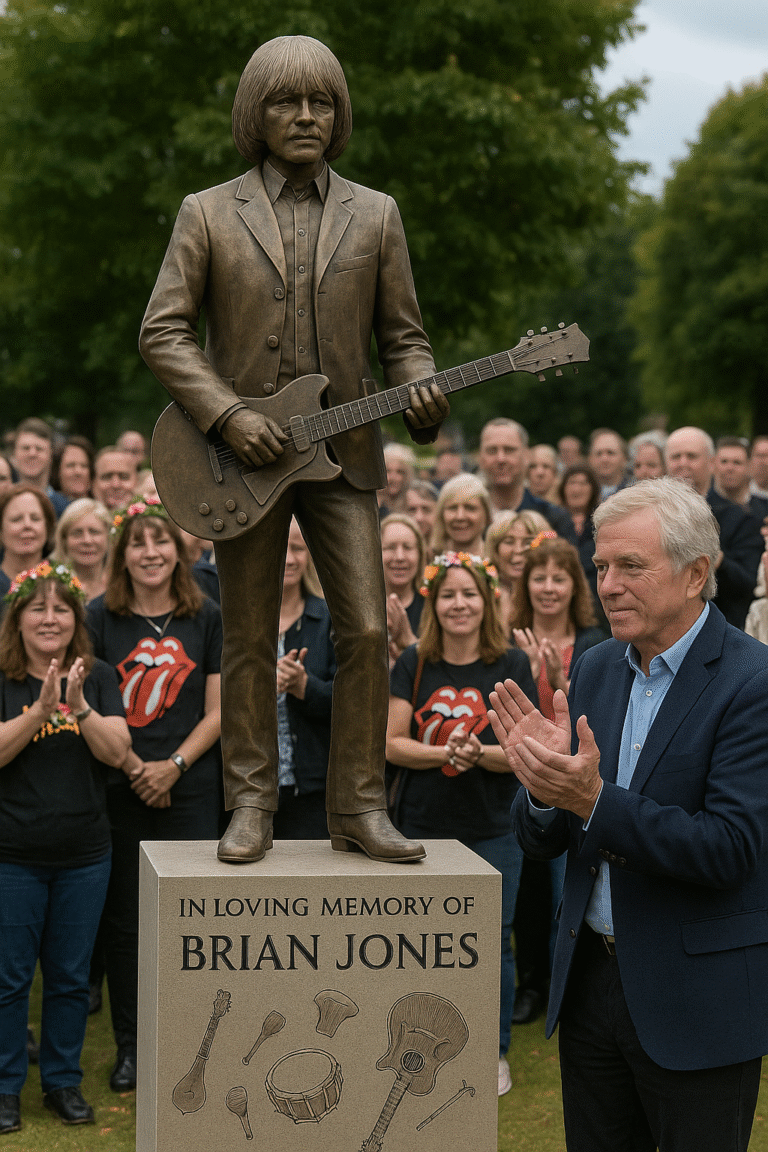In Loving Memory: Rolling Stones Founder Brian Jones Honored With Statue in Hometown
Cheltenham, England – June 7, 2025
Decades after his tragic and untimely death, Brian Jones — the founding member of The Rolling Stones and one of rock and roll’s most enigmatic icons — has finally been memorialized in his hometown of Cheltenham with a statue that captures both his pioneering spirit and lasting musical influence.
Hundreds of fans gathered on a cloudy Saturday morning in Imperial Gardens, a central spot in Cheltenham, for the long-awaited unveiling of a bronze statue commemorating the life and legacy of Lewis Brian Hopkin Jones. The tribute comes 56 years after the guitarist’s mysterious death at age 27, and it marks a moment of long-overdue recognition for the multi-instrumentalist whose visionary ideas helped launch one of the most legendary rock bands in history.
“He Was a Genius Ahead of His Time”
The statue, sculpted by renowned British artist Hazel Reeves, depicts Jones in his signature 1960s mod fashion, holding a teardrop Vox guitar and standing confidently, gazing into the distance. Behind him is a stone plinth etched with some of the many instruments he famously played — including the sitar, marimba, and dulcimer — symbols of the musical experimentation that defined the Stones’ early evolution.
“Brian was a genius ahead of his time,” Reeves said during the ceremony. “This sculpture is meant to reflect his creativity, complexity, and charisma. He shaped the future of music, even if his own time was far too short.”
As the black cloth was pulled away and the statue revealed, fans — many wearing Stones merchandise and flower crowns — erupted into applause and tears. Some placed flowers at the base, while others stood in silence, absorbing the moment.
Remembering the Visionary Behind the Stones
Brian Jones formed The Rolling Stones in 1962, bringing together Mick Jagger, Keith Richards, Ian Stewart, Bill Wyman, and Charlie Watts. Known for his musical versatility and flair, Jones was the driving force behind the band’s formation, name, and early style, blending blues authenticity with British counterculture energy. His ability to master and incorporate unconventional instruments into the band’s sound was revolutionary in the 1960s rock scene.
Though his influence waned in later years due to internal tensions and personal struggles with substance abuse, his mark on the band’s early work — including hits like Paint It Black, Ruby Tuesday, and Under My Thumb — remains undeniable.
Jones was officially dismissed from the band in June 1969 and died just three weeks later in his swimming pool at Cotchford Farm, a death still shrouded in mystery. His passing marked the first in a long string of “27 Club” deaths, forever etching his name in rock tragedy lore.
Hometown Healing and Historic Recognition
Cheltenham, where Jones was born and raised, has had a complicated relationship with his legacy. While many residents and fans have long advocated for a memorial, years of debate about location, design, and funding stalled progress. The statue was ultimately funded through a combination of fan crowdfunding efforts, donations from music foundations, and contributions from local businesses and the Cheltenham Borough Council.
Speaking at the unveiling, Cheltenham Mayor Sarah Gardner emphasized the importance of celebrating homegrown talent:
“Brian Jones changed the course of modern music. He deserves to be remembered not just as a rock star, but as a cultural innovator and one of Cheltenham’s most influential sons.”
Among those in attendance were members of Jones’s extended family, close friends, and notable figures from the British music scene, including former bandmate Bill Wyman, who shared a few words.
“Brian was the spark,” Wyman said. “Without him, there wouldn’t have been a Rolling Stones. He had his demons, but he also had unmatched passion and vision. I think he’d be deeply moved by this.”
Fans from Across Generations Gather
Attendees came from across the UK and even abroad to witness the tribute. Some had seen the Stones perform with Jones in the 1960s; others were too young to have known him during his lifetime but were nonetheless deeply inspired by his legacy.
“I wasn’t born when Brian was alive, but he’s the reason I picked up the guitar,” said 22-year-old musician Liam Forbes, who traveled from Glasgow. “He wasn’t just a guitarist — he was an artist.”
Nearby, an older couple, John and Maureen Delaney, held hands while recalling their first Stones concert in 1965.
“We were heartbroken when Brian died,” Maureen said. “This statue feels like closure. He’s finally getting the love he deserved.”
The Legacy Lives On
Following the ceremony, local bands performed a selection of Rolling Stones classics and Brian Jones-era deep cuts in Montpellier Gardens, turning the day into a celebration of both remembrance and music. Cheltenham’s tourism board also announced plans for a yearly “Brian Jones Music Festival,” set to debut in 2026, which will feature emerging artists, panel discussions on music history, and guided tours of Jones-related landmarks.
As twilight settled over Cheltenham, the newly unveiled statue of Brian Jones stood illuminated — a long-missing monument to a man whose artistic vision helped spark a musical revolution.
In life, Brian Jones was often overshadowed by louder voices and brighter lights. In death, his hometown has given him a lasting tribute that ensures his rhythm, spirit, and legacy will echo on — not just through the songs of the Stones, but in the hearts of all who remember the man who started it all.
